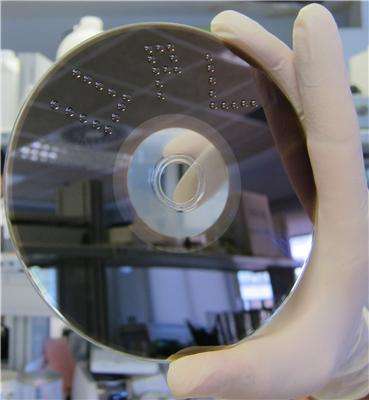Blu-ray player detects microorganisms and toxins on discs

In addition to storing films, optical discs can be used to detect microorganisms, toxins, allergens and tumoral biomarkers. Blu-ray technology has allowed researchers at the Polytechnic University of Valencia to develop a way to find out if a sample contains Salmonella or toxic substances. This simple and cheap analytical system may be applied to clinical diagnosis and environmental monitoring.
A system devised by Chemists at the Polytechnic University of Valencia (UPV, Spain) uses Blu-ray discs and players to detect pathogenic bacteria and toxins in biological samples. The journal Biosensors and Bioelectronics published the study.
"We use the surface of these commercial discs as a platform for analysis to carry out the tests and then, with the laser reader of the recorder/player we can identify the bacteria and determine their concentration," Sergi Morais, one of the authors, explains to SINC.
Specifically, the team has analysed the DNA of two types of pathogenic bacteria in this way: Salmonella typhimurium, which causes salmonellosis, and Cronobacter sakazakii, an intestinal parasite. "The method could be used to detect these and other microorganisms in breast milk or other foods," says Morais.
The researchers also applied Blu-ray technology to determine the concentration of microcystins in water, a kind of toxin that causes gastrointestinal disorders or allergic reactions, and which are produced by cyanobacteria.
"This type of test can also be used to detect tumoral biomarkers, food and drug allergens, and pesticides in water, for example," the researcher states. "The level of pollutants in water and air are regulated by directives that set a maximum residue limit, and the sensitivity of our technique allows analytes below that required by government to be detected."
The samples are deposited in small quantities on the discs in the form of microarrays or two-dimensional arrays. "The hydrophobic nature of the surface of the Blu-ray disc allows the proteins to be locked in place by passive adsorption in a high-density format (64 points in each 1 mm2 drop)," one of the authors, Ángel Maquieira, points out.
"On the 90 cm2 surface of these discs it's possible to imprint 138,000 points, each one 125 µm in diameter," he adds. "Furthermore, the low sample volume used (5-10 microlitres) and the low cost of the developed hardware make this technology a very practical and economically competitive tool".
According to the researchers, the accuracy and sensitivity of these electronic devices is similar to that obtained with conventional laboratory techniques, such as the quantitative polymerase chain reaction (PCR). Though it's not an "official" methodology, the process offers a very practical strategy to eliminate samples before applying more exhaustive analytical techniques. "Samples that are shown to be positive by this methodology will also be positive using the other techniques," Morais explains.
Its characteristics make Blu-ray technology a "promising alternative" due the fact it may be applied to the development of new systems of analysis used in clinical diagnosis, or be used in situ, in the field, in the agrofood industry, and in environmental monitoring.
The study warns that the lack of simple sensor systems that combine a high detection resolution with low costs is the reason why some analytical technologies are not found in installations with a low budget.
More information: Tania Arnandis-Chover, Sergi Morais, Miguel Ángel González-Martínez, Rosa Puchades, Ángel Maquieira. "High density MicroArrays on Blu-ray discs for massive screening". Biosensors and Bioelectronics, 2014.
Journal information: Biosensors and Bioelectronics
Provided by Plataforma SINC, Spain


















